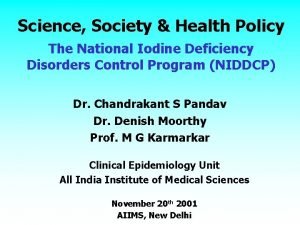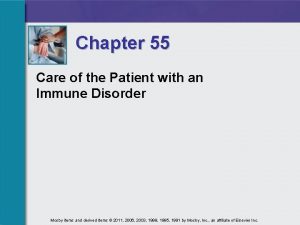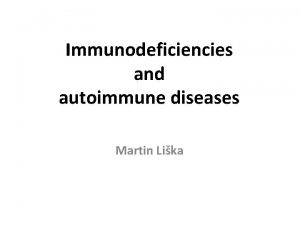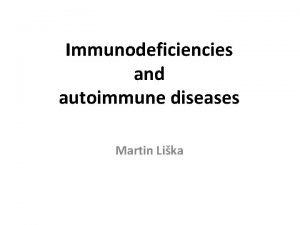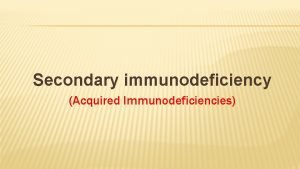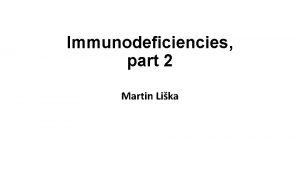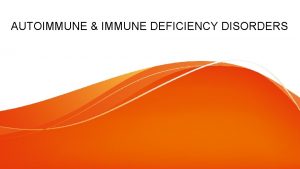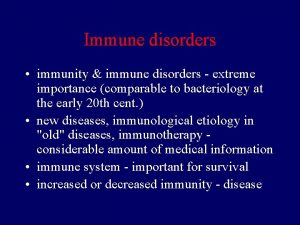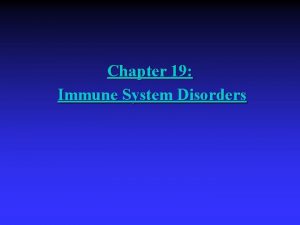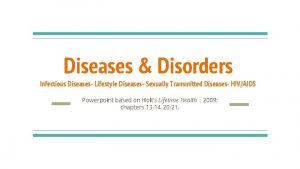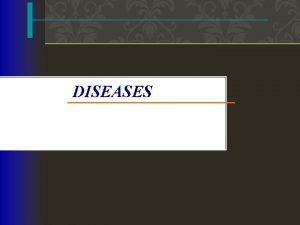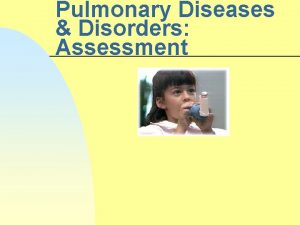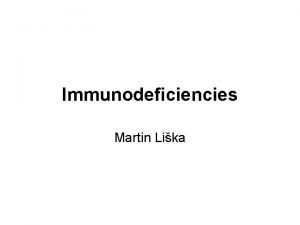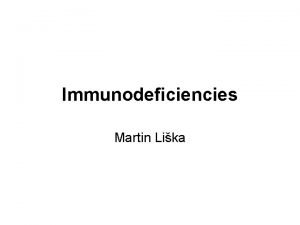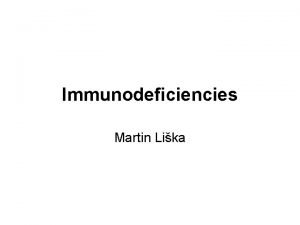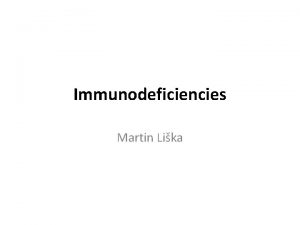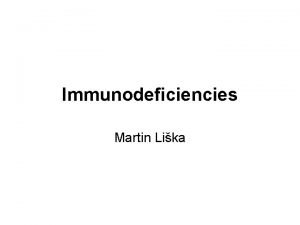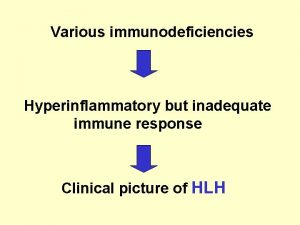Immune deficiency Diseases 2 Immune Deficiency Disorders Immunodeficiencies



















- Slides: 19

Immune deficiency Diseases (2)

Immune Deficiency Disorders Immunodeficiencies can be divided into primary immunodeficiency disorders, and secondary immunodeficiency states, 1 - Primary immunodeficiency; are inherited defects affecting immune system development, 2 - Secondary immunodeficiency; as complication of other diseases. n

Immune Deficiency Disorders n n Clinically; Patients with immune deficiency present with increased susceptibility to infections as well as to certain forms of cancer. The type of infections in a given patient depends largely on the component of the immune system that is affected. Patients with defects in Ig, complement, or phagocytic cells typically suffer from recurrent infections with pyogenic bacteria, whereas those with defects in cellmediated immunity are prone to infections caused by viruses, fungi, and intracellular micro-organisms.

Immune Deficiency Disorders n n Primary Immune Deficiencies: Primary immune deficiency states are fortunately rare. Most primary immune deficiencies come to attention early in life (between 6 months and 2 years of age), usually because the affected infants are susceptible to recurrent infections. Most primary immune deficiency diseases are genetically determined and affect either; Adaptive immunity (i. e. , humoral or cellular) or ¨ Innate host defense mechanisms, including complement proteins and cells such as phagocytes and NK cells. ¨

Immune Deficiency Disorders n n Defects in adaptive immunity are often subclassified on the basis of the primary component involved (i. e. , B cells or T cells, or both); however, because of the interactions between T and B lymphocytes, these distinctions are not clear-cut. For instance T-cell defects frequently lead to impaired antibody synthesis, and hence isolated deficiencies of T cells may be indistinguishable from combined deficiencies of T and B cells.

Secondary Immunodeficiency Disorders n n : Immune deficiencies secondary to other diseases or therapies are much more common than the primary (inherited) disorders. Secondary immune deficiencies may be encountered in patients with: ¨ ¨ ¨ ¨ Infection (HIV) Malnutrition, Aging, Immunosuppression, as in cancer, and renal disease Autoimmunity, Chemotherapy. However, the most common cases of immune deficiency are therapy-induced suppression of the bone marrow and of lymphocyte function.

Acquired Immunodeficiency Syndrome (AIDS) n n AIDS is a disease caused by the retrovirus human immunodeficiency virus (HIV) It is characterized by profound immunosuppression leading to opportunistic infections, secondary neoplasms, and neurologic manifestations

AIDS Risk Groups n 1. 2. 3. 4. 5. Five groups of adults are at risk for developing AIDS: Homosexual or bisexual men Intravenous drug abusers Haemophiliacs Recipients of blood and blood components Heterosexual contacts of members of other high-risk groups. In Children: ¨ ¨ from vertical transmission from the mother to fetus hemophiliacs and others who received blood or blood products before 1985

AIDS Routes of Transmission n Sexual Transmission ¨ The virus is present in the semen, or in vaginal & cervical cells of infected person both extracellular & within the lymphocytes. ¨ Virus enters the recipient's body through abrasions in the mucosa Parenteral Transmission; blood transfusion or drug abusers. n Mother-to-Infant Transmission n

AIDS n Profound immunosuppression, primarily affecting cellmediated immunity, is the hallmark of AIDS

AIDS Pathogenesis There are two major targets for HIV infection: 1 -The immune system : HIV infects CD 4+ T cells leading to their loss as well as an impairment in the function of surviving cells. ¨ Macrophages & dendritic cells are also targets of HIV infection. ¨ B lymphocytes are secondary affected by dysfunctioning T helper cells. 2 - The central nervous system : ¨Macrophages & microglia (monocyte & macrophage derived) in the brain are infected with HIV ¨Neurons are not infected by HIV ¨Exact mechanism of brain damage is unknown, n

Natural History of HIV Infection n The clinical course of HIV infection can best be understood in terms of an interplay between HIV and the immune system. Three phases reflecting the dynamics of virus-host interaction can be recognized: (1) an early acute phase, (2) a middle chronic phase, and (3) a final crisis phase: (1) An early, acute phase; n n n Clinically associated with a self-limited acute illness that develops in 50 to 70% of infected adults The symptoms are non-specific and include sore throat, myalgia, fever, rash +/- aseptic meningitis They develop 3 to 6 weeks after infection and resolve spontaneously 2 to 4 weeks later

Natural History of HIV Infection 2) A middle, chronic phase; n n n There is continuous HIV replication, predominantly within the macrophages & T-lymphocytes, which may last for several years Patients are either asymptomatic or develop persistent generalized lymphadenopathy Many patients have minor opportunistic infections

Natural History of HIV Infection (3) A final, crisis phase; n n n The CD 4+ cell count is reduced below 500 cells/µl After a variable period, serious opportunistic infections, secondary neoplasms and/or neurologic manifestations develop (AIDS-defining conditions = the patient is said to have developed full-blown AIDS= where CD+4 cell count becomes less than 200/ml)

Phases of HIV Infection © 2005 Elsevier

Natural History of HIV Infection n n The HIV patients are classified into three groups according to CD 4+ cell count: (1) Patients with counts >500 cells/µL who are generally asymptomatic (2) Patients with counts between 200 & 500 cells/µL who have early symptoms (3) Patients with counts <200 cells/µL who have severe immunosuppression (AID’s patient).

Opportunistic infections n n n Opportunistic infections have accounted for approximately 80% of deaths in patients with AIDS. Their spectrum is constantly changing, and their incidence is decreasing markedly as a result of more effective highly active antiretroviral therapy. PROTOZOAL (toxoplasmosis) FUNGAL INFECTIONS (candida) BACTERIAL INFECTIONS (mycobacteria) VIRAL INFECTIONS (cytomegalovirus)

Neoplasms n Kaposi sarcoma: A vascular tumor that is otherwise rare in the United States. n Non-Hodgkin lymphoma : They involve the nodes as well as extranodal sites such as liver, gastrointestinal tract, and bone marrow. They are primarily high-grade diffuse B-cell neoplasms n n Primary lymphoma of brain. Invasive cancer of uterine cervix: This is attributable to a high prevalence of human papillomavirus infection in patients with AIDS whose immune systems are compromised.

CNS Involvement 40% to 60% of patients have clinically evident neurologic dysfunction. n In addition to opportunistic infections and neoplasms. n And progressive encephalopathy clinically designated the AIDS-dementia complex n
 A subsequent
A subsequent Deficiency chart of macronutrients
Deficiency chart of macronutrients Protein deficiency diseases
Protein deficiency diseases Major nutritional deficiency diseases in emergencies
Major nutritional deficiency diseases in emergencies Milady chapter 8 skin disorders and diseases
Milady chapter 8 skin disorders and diseases Chapter 21 mental health diseases and disorders
Chapter 21 mental health diseases and disorders Chapter 8 skin disorders and diseases
Chapter 8 skin disorders and diseases 10 diseases of lymphatic system
10 diseases of lymphatic system Chapter 17 reproductive system diseases and disorders
Chapter 17 reproductive system diseases and disorders Milady chapter 10 review questions
Milady chapter 10 review questions Chapter 8 skin disorders and diseases
Chapter 8 skin disorders and diseases Chapter 15 nervous system diseases and disorders
Chapter 15 nervous system diseases and disorders Chapter 8 cardiovascular system
Chapter 8 cardiovascular system Chapter 6 musculoskeletal system
Chapter 6 musculoskeletal system Nail diseases and disorders milady
Nail diseases and disorders milady National iodine deficiency disorders control programme
National iodine deficiency disorders control programme Virosome
Virosome Chapter 55 care of the patient with an immune disorder
Chapter 55 care of the patient with an immune disorder What is the third line of defense in the immune system
What is the third line of defense in the immune system Thymus
Thymus















